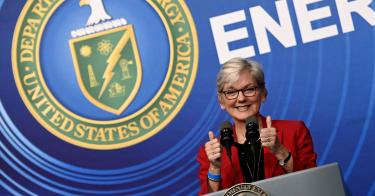Energy Secretary Jennifer Granholm announced to much fanfare earlier this month that scientists have reached a major milestone in fusion energy research.
After decades of research and billions of taxpayer dollars, scientists at the Lawrence Livermore National Laboratory National Ignition Facility successfully produced a fusion reaction that yielded more energy than was used to initiate the reaction.
To do this, the Livermore scientists aimed 192 lasers at a hydrogen fuel pellet about half the size of a peppercorn to produce 3.15 megajoules of energy using only 2.05 megajoules. That’s a 50% increase.
Although this is a tiny amount of energy, it’s a big deal because it proves that controlled fusion can produce net positive energy. This is an essential characteristic necessary to produce energy economically for consumer use.
By and large, it is within this context that most media and politicians are commenting on the news Granholm announced Dec. 13. They see this as a breakthrough for America’s clean energy future.
That might be true, but it’s only half the story.
Fusion research broadly, and this achievement specifically, is critical for America’s national security. Indeed, it’s the primary reason that scientists at Livermore National Laboratory, one of the primary national security labs responsible for nuclear weapons activities, are working on the technology in the first place.
Putting aside whether the United States should be testing nuclear weapons, fusion research helps to ensure the safety, reliability, and effectiveness of weapons, absent actual testing.
Thus, this is a big win for science and for the important work done at America’s national laboratories.
But here is the big question:
Now what?
Of course, as is standard fare in Washington, first the politicians take some credit for the achievement and then promise to double down on their commitment with your money. And much of that money has nothing to do with basic research or national security benefits, but rather on developing, commercializing, and deploying fusion reactors for commercial application.
This is the wrong approach for both national security and commercial application.
The right answer is that fusion plays an important role in national security, specifically in maintaining our nuclear deterrent. For this purpose, government research should continue toward that end.
And it must be protected. No one should consider the research at Livermore National Laboratory a scientific gift to humanity. It must be closely guarded against theft from America’s competitors and enemies.
It’s not a semantic point. The purpose of the research and testing drives all kinds of smaller decisions within the program that affect the taxpayer.
From an energy deployment standpoint, government does a poor job of commercialization projects. That’s not to say that government research can’t lead to successful commercial enterprises, but how that technology enters the marketplace matters.
Take GPS, for example. Although we depend on GPS today to find everything from the newest burrito stands to Grandma’s house, the technology was developed purely on national security grounds.
America understood early in the Cold War that it needed ever more accurate weapons and that emerging space technologies were key to unlocking that capacity, and over decades developed what we now know as GPS.
But the technology originally wasn’t available for commercial use. Civilian use of GPS didn’t occur until 1983, when President Ronald Reagan authorized the technology for use by airplanes, which soon was followed by broader commercial availability.
The private sector saw the commercial promise of GPS and took an expensive military technology and developed the affordable consumer and producer products that we all enjoy today.
Government never could have done that.
A good counterexample is fission nuclear energy. Like GPS, fission reactors were developed for national security purposes, including those that initially were built for commercial application, though indirectly.
Despite alleged early promises of being “too cheap to meter,” and proven experience demonstrating that nuclear fission reactors are safe, clean, and reliable, these reactors haven’t reached their full commercial potential.
This is not because they’re inferior to other energy options. They’re not. That the fission industry had any success at all is testament to the underlying technology and resilience of America’s commercial nuclear firms. It isn’t more successful because, in many regards, government never actually stepped aside to allow an independent, vibrant, and competitive commercial nuclear industry to emerge.
Government either has tried to stifle or support commercial nuclear fission—and usually some combination of both simultaneously. Government hasn’t given the industry a predictable playing field where it could succeed (or fail) on its own.
The Livermore achievement now leaves the nation at a crossroads on fusion energy.
Do we want a fusion industry that is independent, vibrant, and competitive? Or do we want one that is stifled by government bureaucrats and annual battles in Congress over funding and subsidies?
The private sector is answering that question with dollars. According to the Fusion Industry Association, private investment in 2022 will exceed $4.7 billion, a 139% increase from 2021. It’s money that tens of companies are using to build, test, iterate, and improve fusion because they believe in the product.
This should surprise no one, because with a U.S. energy economy worth around a trillion dollars annually (and much more globally), the prize is huge and could lead to massive valuations for the companies that succeed.
But for this to happen, government needs to steer clear of commercial development of fusion technology and instead refocus its efforts on the national security function of fusion research.
If fusion turns out to be a competitive method of providing energy, private investors will figure out how to do it faster and cheaper than government ever could.
Lewis Strauss, former chairman of the Atomic Energy Commission, is credited with making the “too cheap to meter” comment. But in an interesting historical twist, the former chairman may not have been talking about fission at all, but actually fusion.
Will Strauss have the last laugh from above on his oft-criticized quote?
Not if Washington has anything to do with it.
This piece originally appeared in The Daily Signal




